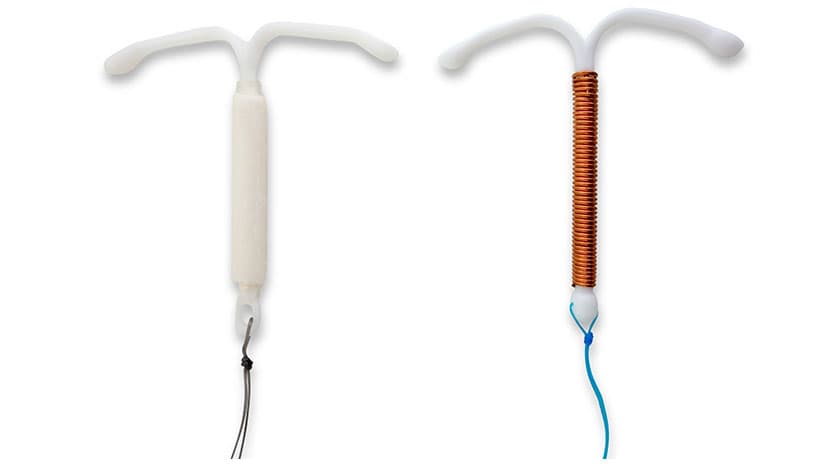What you need to know about long-lasting reversible contraceptives such as IUDs and implants

The two types of intrauterine devices are hormonal IUDs, left, and copper IUDs.
If you’re looking for highly effective birth control that you don’t have to think about every day, you may want to consider long-lasting reversible contraceptives. These intrauterine devices (IUDs) and implants are inserted — and eventually replaced or removed — by your doctor and require no maintenance.
IUDs
What are the different types of IUDs?
There are two types of IUDs, which are small T-shaped devices placed in the uterus to prevent pregnancy: copper IUDs and hormonal IUDs. Copper IUDs work by releasing copper ions that are toxic to sperm. Hormonal IUDs work by thickening your cervical discharge so that it's difficult for sperm to make their way to an egg in the fallopian tubes. In some patients, the hormonal IUD can inhibit ovulation so you don't release an egg. Some IUDs can also be used as emergency contraception if they are inserted within five days of sexual intercourse.
How is an IUD placed?
First, we do a pelvic exam to see which way your uterus points and where your cervix is. We use a speculum to widen the vaginal opening, clean off your cervix with an antiseptic solution and then typically use a forceps-like instrument called a tenaculum to grasp your cervix. This helps straighten out your uterus so that we can safely place the IUD. We use an instrument called a “sound” to measure your uterus to make sure the IUD will safely fit, and then we insert the IUD and trim its strings to about an inch.
Both the copper and hormonal IUDs are more than 99% effective in preventing pregnancy.
Does getting an IUD hurt?
Patients typically experience cramps at specific points in the procedure, particularly when the cervix is grasped, during measurement of the uterus and when the IUD is going in. We want to make you as comfortable as possible during the insertion procedure, and we offer a local numbing anesthetic for the area between your cervix and vagina to help alleviate the pain and discomfort. Taking ibuprofen before and/or after your visit can also help alleviate the pain, as can a heating pad. We highly suggest taking it easy on the day your IUD is inserted, as strenuous activity can make pain and discomfort worse.
It’s important to know that you may experience intermittent cramping or bleeding during the first month after getting your IUD. This is completely normal, as it’s your body adjusting to this new form of contraception. If you continue to experience severe cramping and heavy bleeding, make an appointment to see your gynecologist.
How effective are IUDs?
Both the copper and hormonal IUDs are more than 99% effective in preventing pregnancy. Copper IUDs are effective immediately after insertion and last for 12 years (depending on the brand). Hormonal IUDs can also be effective immediately depending on where you are in your cycle; otherwise, they reach full effectiveness after one week post-insertion. Depending on the brand of hormonal IUD used, they typically provide pregnancy prevention for up to three to seven years. During your annual exam, make sure your gynecologist checks your IUD to ensure it's still in the right spot and raise any concerns or questions you have regarding your IUD.
Will an IUD stop my period?
With the copper IUD, you will typically have your period once a month, and it may be more painful and heavier. Because hormonal IUDs cause the lining of your uterus to be thin, there is less lining to be shed and you may experience a lighter, less painful period or even no period at all.
How is an IUD removed?
Like IUD placement, it's a quick procedure that takes only a few minutes. A speculum is used to widen the vaginal opening, and the IUD is retrieved by pulling on the strings. Your fertility will return immediately, so don’t forget to talk with your doctor about getting another IUD or other form of contraception if you don’t wish to become pregnant.
Are hormonal IUDs bad for your health?
Hormonal methods of contraception are very safe and effective to use and can provide relief for heavy or painful periods. They contain progestin, a safe, synthetic version of progesterone that’s been used for decades. These IUDs have some of the lowest hormone doses of any contraceptive method, much lower than birth control pills. It’s important to remember that all bodies react differently to medication, though. Just because a form of hormonal contraception doesn’t work for your friend, sister or mother, that doesn’t mean it won’t work for you.
Patients who can’t or don’t want to use hormonal IUDs due to certain medical conditions, medications or personal preference may wish to try the copper IUD, which contains no hormones.
Contraceptive implants
What is a contraceptive implant?
This is a small, matchstick-like rod containing the hormone progestin that is implanted under the skin. The hormone is slowly released into your body and works by thickening your cervical discharge as well as preventing an egg from being released.
How is the implant placed and removed?
After selecting which arm you would like to use for the implant, we sterilize an area on your upper arm that is roughly two to three inches above your elbow. Then, we numb the area with a needle and use a special device to insert the implant. You will not need stitches! A small adhesive bandage will be placed over the insertion site and you’ll need to keep the area covered for three to five days. Using a compression bandage over the insertion site for about 24 hours can help decrease any bruising.
The implant does not require maintenance — you just need to make sure you can feel it under the skin. If for some reason you suddenly can't, you need to visit your gynecologist and have it removed. On rare occasions, implants placed too deep during insertion can migrate. To remove the implant, we numb the skin and make a tiny incision to pull the implant out.
Implants are the most effective method of contraception and are over 99% effective at preventing pregnancy when properly inserted.
What are the contraceptive implant’s side effects?
Side effects can include irregular bleeding, mood swings, weight gain and headaches.
How effective are contraceptive implants?
Implants are the most effective method of contraception and are over 99% effective at preventing pregnancy when properly inserted. The implant works immediately if inserted during the first five days of your period, but is otherwise effective after one week. You must remember to change out the implant every three to five years, depending on the brand.
Will the implant stop my period?
Most patients report their period lightens when using the implant. However, the bleeding pattern is often highly unpredictable, from no bleeding, to spotting, to bleeding for a week or two over a month. It all depends on how your body adjusts to this method of contraception.
How much do IUDs and contraceptive implants cost?
Although prices vary, many insurance plans cover IUDs and contraceptive implants. Ask your gynecologist what long-lasting contraceptive methods might work best for your unique situation and whether they’re covered by your insurance.

Neha R. Bhardwaj, MD, MS
Gynecologist Neha Bhardwaj, MD, MS, is an expert is complex contraception, helping women and families who have trouble conceiving due to a wide range of health challenges.
Learn more about Dr. Bhardwaj